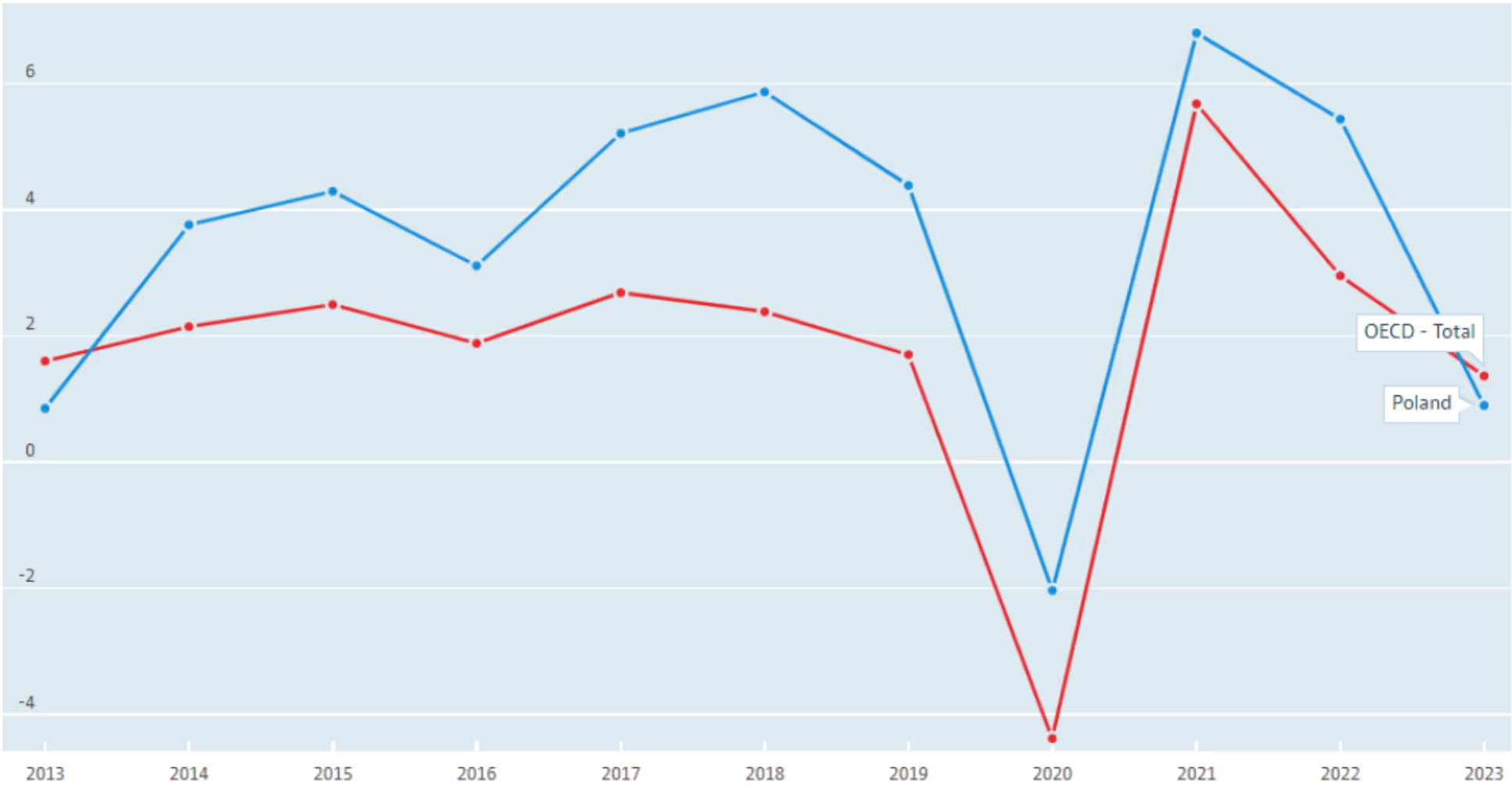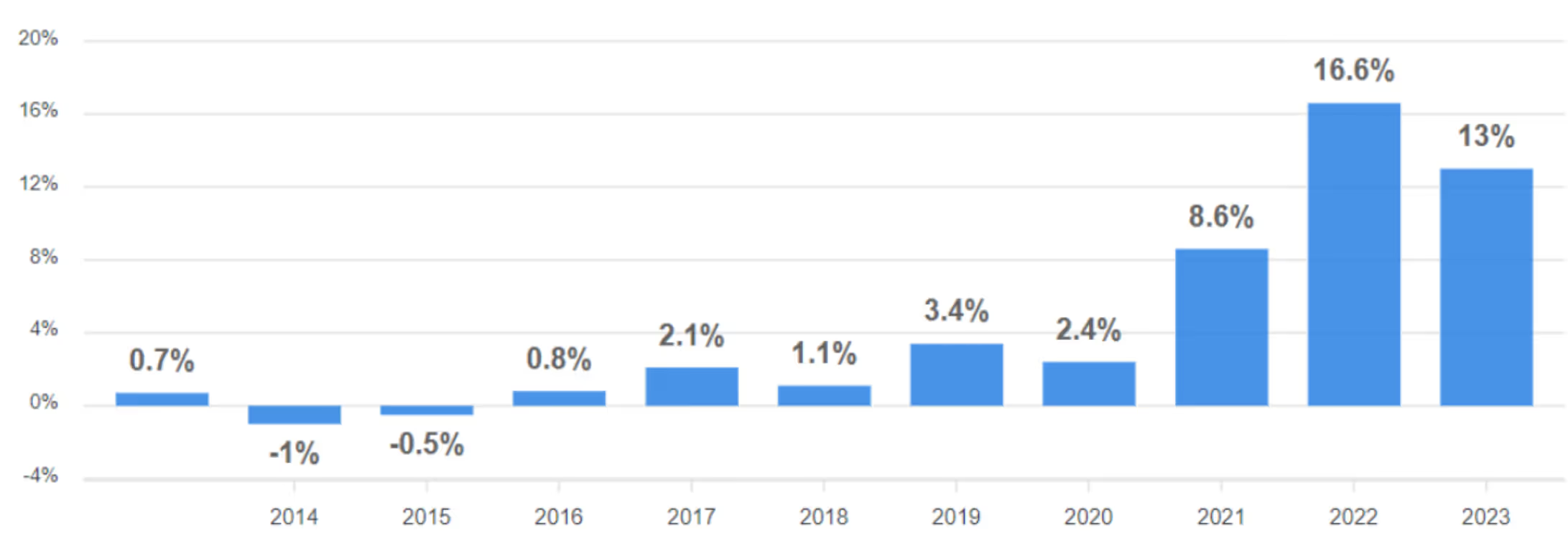About
Polish Real Estate Investment Report | Economic Indicators of Poland for Real Estate Investors
Author
Pierre Macardier
Industry
Chapter 1
Duration
10 minutes
Solution
Real Estate ManagementContent
Poland has solidified its position as a key player in the European real estate market. Over the last decade, its robust economy, favorable foreign investment climate, and increasing consumer purchasing power have drawn investors from around the globe. This comprehensive analysis examines Poland’s economic growth, inflation trends, foreign direct investment (FDI), and market stability, shedding light on the factors that make Poland an attractive real estate investment destination. The Polish real estate market has seen recent growth in property prices, and investors should consider essential legal and tax considerations when navigating this market.
1. Overview of the Polish Economy
1. Economic Growth: A Decade of Steady Expansion
Poland’s economy has consistently outperformed many European counterparts. Between 2013 and 2023, Poland recorded an average annual GDP growth of 3.5%, significantly higher than the OECD average of 1.9%. Highlights of GDP growth include:
- 2013: 0.9% growth, marking a gradual recovery from the global financial crisis.
- 2017–2018: Exceptional growth rates of 5.1% and 5.9%, respectively, due to increased exports and domestic consumption.
- 2020: A contraction of -2% due to the COVID-19 pandemic, though recovery was swift in 2021 with a 6.8% growth.
- 2023 (forecasted): A modest growth of 0.7%, reflecting temporary global economic challenges.
Poland’s strategic location and diversified economy have supported this robust performance, providing a stable foundation for property investment.

1(GDP Growth (Annual %) - Poland | Data, n.d.)
2(Economic Forecast for Poland, n.d.)
3(GDP and Spending - Real GDP Forecast - OECD Data, n.d.)
2. Inflation Trends: Managing Volatility
Inflation in Poland has fluctuated over the decade, influenced by both domestic and global factors. The average inflation rate from 2013 to 2022 was 3.4%, slightly above the European Central Bank’s (ECB) target of 2%. Key milestones include:
- 2014–2015: Periods of deflation (-1% and -0.5%) due to low commodity prices.
- 2022: Inflation peaked at 16.6% amid rising energy costs and supply chain disruptions caused by the Russia-Ukraine war.
- 2023: The inflation rate stabilized at around 13%, as global markets adjusted to post-pandemic realities.
Inflation impacts rental income and the rental market by influencing rental yields, which are crucial for real estate investments. Higher inflation can lead to increased rental income, but it also affects the rental market dynamics, including demand and rental yields.

As a result, the average inflation rate for the period 2013-2022 was 3.4%, which is slightly higher than the ECB recommended policy of maintaining a 2% inflation rate over the medium term. One of the main factors behind this was the high prices of raw materials, commodities, and Russia’s invasion of Ukraine (which resulted in the migration of 3 million5 Ukrainian refugees to Poland).
Sanctions imposed on Russia disrupted supply chains and significantly worsened consumer and business sentiment. The gradual withdrawal of European countries from supplying cheap energy raw materials from Russia increased operating costs, which ultimately prompted companies to raise the prices of their products.
(Poland Inflation Rate - 2023, n.d.) (What Do Refugees Who Fled Ukraine Face in Poland? | International Rescue Committee (IRC), n.d.) (Inflation in Poland - Statistics & Facts | Statista, n.d.)
3. Foreign Direct Investment: A Magnet for Global Capital
Poland’s FDI net inflows averaged 3.2% of GDP from 2013 to 2021, significantly outpacing the EU average of 2.4%. Key drivers include:
- A well-educated workforce and competitive labor costs.
- Government incentives for foreign investors, particularly in the real estate and manufacturing sectors.
- Strategic infrastructure projects, including transport and logistics hubs.
Foreign investors can also find lucrative opportunities within the Polish real estate market, which requires navigating critical legal and tax considerations, such as investment regulations and taxation on rental income.

Poland’s ability to attract FDI underscores its stability and appeal as a long-term investment destination. This demonstrates Poland’s remarkable success in attracting foreign direct investment, emphasizing its status as an attractive investment destination. The World Bank7portrayed this trend with the graphical representation of the phenomenon.
4. Economic Stability: The Backbone of the Market
Poland’s economy is a beacon of stability in Europe, characterized by consistent growth and resilience. As the largest country in Central and Eastern Europe and the sixth largest in the European Union, Poland has established itself as a robust and attractive market for businesses and investors alike. Key highlights of Poland’s economic stability include:
The attractiveness of Poland is further enhanced by the availability of comprehensive services for managing real estate investment projects, including acquisition, renovations, renting, and property management.
Resilience During Global Challenges
- Poland was the only European country to avoid a recession during the 2008–2010 global financial crisis, underlining the strength of its economic foundations. The stability of property management services in Poland further enhances this resilience, offering comprehensive management from acquisition to tenant placement for both residential and commercial properties.
- Over the past 25 years, Poland’s economy has grown at a steady pace, with GDP per capita now exceeding 70% of the EU average (in terms of purchasing power parity).
Key Drivers of Growth
- Exports:
- Poland’s export-oriented strategy has significantly bolstered its economy.
- Between 2013 and 2021, exports of goods and services as a percentage of GDP grew from 46% to 57.9%, a 12% increase in under a decade.
- This growth reflects Poland’s commitment to developing local industries and leveraging its strategic position in Europe.
- Domestic Consumption:
- Consumer spending in Poland has steadily increased, driven by rising wages and improving living standards.
- Growth in per capita spending highlights the population’s increased purchasing power and economic confidence. Understanding how many property units are needed is crucial for effective negotiations in the real estate market.

Attractiveness for Investors
Poland’s stable economic environment and growth-oriented policies make it an attractive destination for both foreign and domestic investors. The combination of:
- Strong export performance,
- Rising consumer demand, and
- A diversified economy positions Poland as a top choice for long-term investments in sectors like real estate, manufacturing, and technology.
This mix of export strength and growing domestic consumption showcases Poland’s balanced and resilient economic framework, ensuring sustainable growth and a bright future for investors. Engaging with a real estate developer can further secure favorable deals for investors looking to capitalize on high rental potential and low-risk properties.
5. Legal and Regulatory Framework
Poland boasts a well-established and transparent legal and regulatory framework for real estate investment. Operating under a civil law system, the country places a strong emphasis on property rights and contractual obligations, providing a secure environment for investors. Foreign investors enjoy the freedom to buy, sell, and rent out properties, although certain restrictions may apply to specific types of properties, such as agricultural land or those in sensitive areas.
The Polish government has introduced various incentives to encourage foreign investment, including tax breaks and subsidies for specific projects. Additionally, Poland has a well-developed system of property registration and titling, ensuring that securing property rights is straightforward. When it comes to real estate tax, Poland maintains a relatively low tax burden compared to other European countries, with rates ranging from 0.2% to 0.5% per annum based on the property’s value. This favorable tax environment further enhances Poland’s appeal as a real estate investment destination.
6. Opportunities in the Real Estate Market
Poland’s economic trends create a favorable environment for various real estate investment opportunities:
- Residential Properties: High demand due to urbanization and an influx of Ukrainian refugees. Note that selling a property within five years of purchase is subject to a 19% capital gains tax based on the difference between the sale and purchase prices.
- Commercial Real Estate: Office spaces and retail properties thrive in Poland’s growing urban centers. The number of property units a buyer wishes to acquire significantly impacts investment negotiations with property owners or developers.
- Industrial and Logistics: Poland’s central location in Europe makes it a prime hub for logistics and warehousing. Investors can explore a range of real estate projects, from traditional buy-to-let apartments to complex developments like flipping properties and acquiring residential or commercial buildings.
7. Regional Real Estate Markets
Poland’s regional real estate markets present a wealth of opportunities for investors. Major cities such as Warsaw, Krakow, and Gdansk serve as bustling hubs for business and commerce, driving high demand for both office and residential properties. Beyond these major urban centers, regional cities like Poznan, Wroclaw, and Lodz are also experiencing significant growth and development, offering diverse investment opportunities in residential, commercial, industrial, and logistics sectors.
Some of the most promising regional real estate markets in Poland include:
- The Tri-City area (Gdansk, Gdynia, and Sopot): A major business and commerce hub in northern Poland.
- The Krakow region: Renowned for its historic architecture and cultural attractions, making it a vibrant real estate market.
- The Wroclaw region: A key center for business and commerce in southwestern Poland, attracting significant investment.
- The Poznan region: A major logistics and transportation hub in western Poland, offering substantial growth potential.
Overall, Poland’s regional real estate markets provide a range of opportunities for investors, from thriving major cities to dynamic regional centers, making it a versatile and attractive investment landscape.
8. Conclusion: Why Invest in Poland Real Estate?
Poland's economic resilience, strategic location, and investor-friendly policies make it one of Europe's most attractive real estate markets. By leveraging the insights from this decade-long analysis, investors can confidently navigate Poland's dynamic property market.
FAQs About Poland Real Estate Investing
1. Is Poland a good country for real estate investment?
Yes, Poland's stable economy, rising consumer demand, and government incentives make it an excellent choice for real estate investors.
2. How has inflation affected Poland's real estate market?
Inflation has increased property prices but also boosted rental yields, making real estate a viable hedge against rising costs.
3. Which cities are the best for real estate investment in Poland?
Warsaw, Kraków, Wrocław, and Gdańsk are top choices due to their growing populations and economic activity.
4. What is the average ROI on real estate in Poland?
Returns vary by property type and location, but investors can expect rental yields between 4–7%.
5. How does Poland compare to other European real estate markets?
Poland offers higher growth potential and better affordability compared to Western European markets.
6. Are there government incentives for foreign investors?
Yes, Poland provides tax incentives and grants for foreign investors, particularly in strategic sectors like real estate and logistics.
Polish Real Estate Market Report Chapters
Report
Dive into our comprehensive report on the Polish real estate market, offering detailed chapters that explore key economic indicators, market comparisons, legal frameworks, and infrastructure development. Perfect for international investors, this report provides valuable knowledge on sustainable investing, foreign investment statistics, and risk assessment—helping you make informed decisions with confidence.
8.3%
Average ROI in Poland's Real Estate Market
Experience consistent growth. Our clients achieve an impressive 8.3% annual ROI, backed by deep market expertise.
+60
Successful Client Journeys
Discover how international investors have turned opportunities in Poland into thriving portfolios with our dedicated guidance.
$100M
In Real Estate Acquisitions
With our expertise, investors have successfully purchased over $100 million worth of real estate in Poland—unlocking both profit and long-term growth.
.svg)
.svg)
.svg)


.svg)









.avif)


.avif)

.svg)






.avif)


